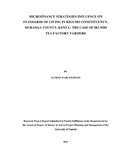| dc.description.abstract | Introduction of microfinance in Bangladesh by Mohammed Yunus was such a relief to
millions of people who were locked up in poverty. The Microfinance in that country was
credited with reduction of poverty whose at the beginning was at 80% of the republic.
The concept addressed the challenge of collateral and lack of information which had kept
the poor from accessing credit facilities. Even women now were in a position to
transform their lives using credit increasing the household consumption and also helping
to reduce the dependency ratio. Retrogressive cultural values that hindered women from
active participation in economic activities were also challenged opening the economic
field for the both genders. The impact was felt in all sectors including health and
education. Despite the success, studies have shown that although the microfinance is
credited with much success there are instances where the net effect has ended up being
negative. This is where instead of the credit facilities empowering the people they have
ended up impoverishing them. In Kenya despite the high number of microfinance’s the
poverty level is still as high as 42.5% with some regions having poverty level as high as
70%.This has necessitated a critical look at the operations of Microfinance in Kenya with
an aim of identifying the gaps to ensure success of Microfinance in Kenya. This study
therefore focused on assessing the influence of Microfinance strategies on improvement
of standards of living in Kigumo constituency. This was done through a study of
microfinance activities in Kigumo constituency, Murang’a County. The target population
was 7,003 farmers who constituted the total number of tea growers in Ikumbi factory and
three field officers serving the farmers. Krejcie and Morgan table was used to identify the
sample size with systematic sampling being used to identify the exact number to
constitute the 364 sample size where every 19th farmer was picked. Census was used on
the case of the field officer due to their low number. The data was collected using
interview questionnaires guide. Descriptive statistics was used to analyze the quantitative
data using statistical package for social sciences (SPSS) and the information presented
using tables. Qualitative data was analyzed using content analysis, a technique that allow
for inferences to be systematically and objectively made. The research showed that
accessibility of the MFIs had a positive impact on the standards of living of the people
and to ensure that there was maximum gain the study recommended that there was need
to incorporate the different characteristics of the population to ensure even the vulnerable
groups were able to access the service. Products were also found to play great role on
improving the standards of living with the need for information sharing and
diversification being emphasized to increase the opportunities for financing. The study
also found the policy to be playing great role in ensuring the goals are achieved. The
study therefore recommended that the policy make the standards of living improvement a
part of the main objectives on the existence of MFIs to guide aspect such as interest rates
and monitoring and evaluation on the impact of services on the clients. On monitoring
and evaluation, the study found that the MFIs were not committed towards improving the
living standards of the people and it was recommended that the definition needed to be
changed to ensure that it also covered the improvement of standards of living and set
indicators that will allow for monitoring and evaluation and ensure success of MFIs in
improving the standards of living for the people | en_US |

